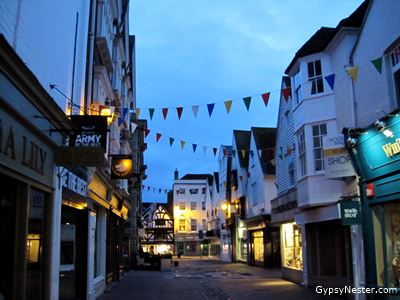
Through our years of traveling we have tried to come up with all sorts of tricks to outsmart jetlag. Drink lots of water (just have to climb out of our seats to pee mid-flight), take sleeping pills (wake up super groggy and nod off in the customs line, or don’t sleep much the night before (see previous problem).
In general, they don’t work, but we have found that when flying overnight from east to west (such as from the US to Europe) it seems to help if we can force ourselves to stay awake for the first day in an effort to get our bodies on to the local time.
 With this in mind we decided to hop on a bus, then a train, straight from London’s Heathrow to the highly historic hamlet of Salisbury on our last trip across the pond. Our intention, and the inspiration for our attempt to fight off the forces of exhaustion, was to use the town as a launching pad for a visit to Stonehenge.
With this in mind we decided to hop on a bus, then a train, straight from London’s Heathrow to the highly historic hamlet of Salisbury on our last trip across the pond. Our intention, and the inspiration for our attempt to fight off the forces of exhaustion, was to use the town as a launching pad for a visit to Stonehenge.
That worked fine, but we also discovered a town well worth exploring in its own right.
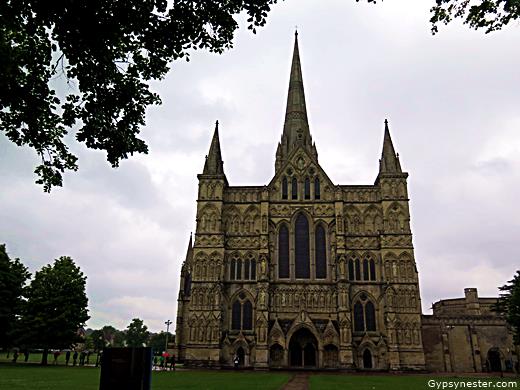 The village is dominated by the Cathedral of the Blessed Virgin Mary. It would be impossible for it not to be, since the church tower sports the tallest spire in the UK.
The village is dominated by the Cathedral of the Blessed Virgin Mary. It would be impossible for it not to be, since the church tower sports the tallest spire in the UK.
Building began way back in 1220, with the final touches on the tower being added about one hundred years later. We’ve seen a lot of churches in our wanderings and have to say that this is one of the most impressive we ever laid eyes on. It certainly helped us in our effort to keep them open.
 The magnificent cathedral was built to replace the church at Old Sarum, the site of the original settlement and castle that we stopped at on our way back to town from Stonehenge. This hilltop fortress has mostly disintegrated now, but served as a stronghold since 400 BC.
The magnificent cathedral was built to replace the church at Old Sarum, the site of the original settlement and castle that we stopped at on our way back to town from Stonehenge. This hilltop fortress has mostly disintegrated now, but served as a stronghold since 400 BC.
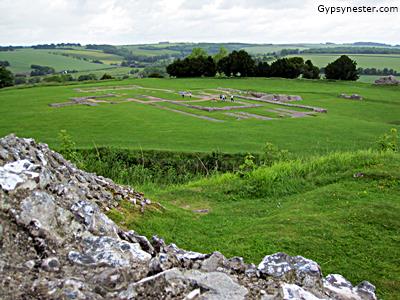
Each new group that came to power used it, as Romans, Saxons, and Normans all took control over the course of some fifteen centuries. Very little is left today, but we could clearly see the foundation of the old church just beyond the moat that protected the castle.

When it was decided to move the city, legend has it that the bishop fired an arrow to mark a spot for the new church. Trouble is he hit a deer.
The wounded animal ran several miles before ultimately dropping on the site of the current cathedral.
It is also possible that the bishop already owned the land and simply donated it, but that’s not nearly as good of a story.
By the time we got back to Salisbury to check out the church it was closed, so we made plans to come back for a look at the inside in the morning.
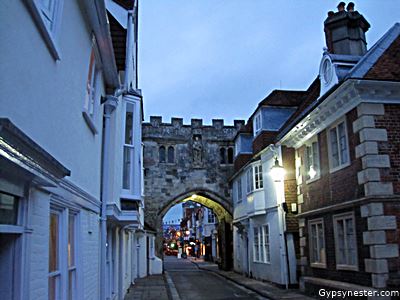
Still, we had some time to kill if we were going to live up to our jetlag reduction method, so we set out to explore the rest of town as the sun was beginning to fade.
Leaving the cathedral, we passed under the High Street Gate into the center of the old city.
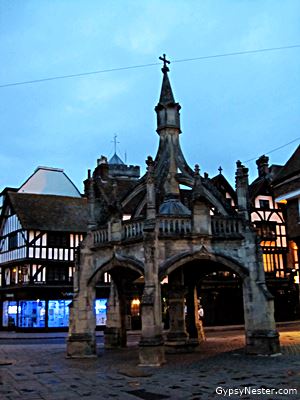
The passage was built early in the fourteenth century with stones taken from Old Sarum.
It is the only remaining of the four that once allowed access within the protective wall that had been constructed around the Cathedral precinct.
Beyond the gate we came to a market cross. These elaborate markers indicate a market square that was authorized by royalty or the bishop to sell certain items.
This one was for poultry, but other crosses once stood in Salisbury that marked spots for buying cheese, livestock, and wool.
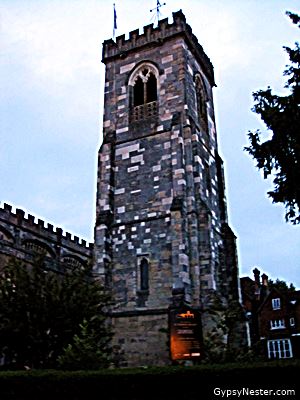
Just down the quickly darkening street the tower from St Thomas’ Church caught our sleepy eyes.
This stately church, named for St Thomas Becket, was built for the workers constructing the cathedral back in 1219 and is best known for its intriguing medieval mural depicting heaven and hell on Judgment Day.
By the time we made it to the old clock tower on Fisherton Street signs of daylight were nearly gone, and so was our ability to stay awake.
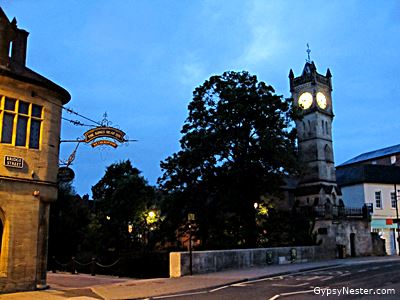
The tower had once served as a jail, and in our current condition we would have been OK with those accommodations, but luckily our inn, The King’s Head, was right across the bridge.
After some fish and chips washed down with a couple of pints, we were out like lights.
Bright and early the next morning we felt as though our jetlag eradication mission had been accomplished. Our body clocks seemed reasonably synchronized to the time zone we were occupying.
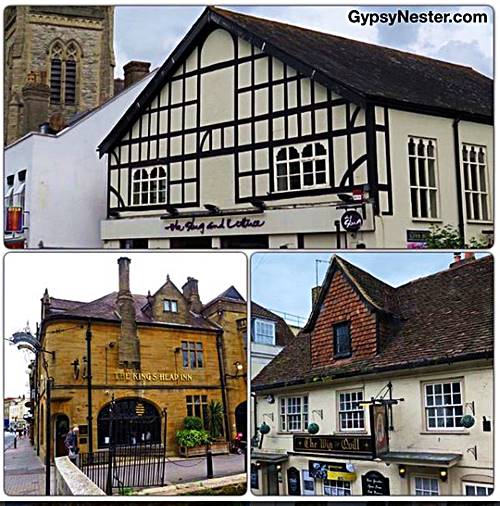
We revisited the sights from the night before with brighter eyes and then noticed something we had missed, quirky pub names. The King’s Head struck us as a little off the wall, but right across the street we saw The Slug & Lettuce, and a bit later the Wig & Quill. Got to love it!
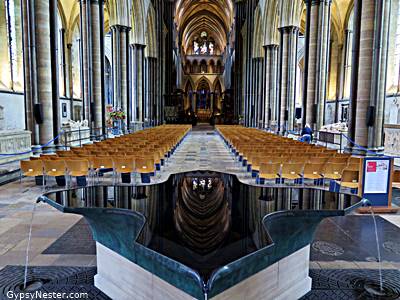
Upon returning to the cathedral we found the inside to be just as impressive as the exterior.
We also discovered an unexpected surprise. The church was hosting a dramatic display of life-sized sculptures called Shadows of the Wanderer.
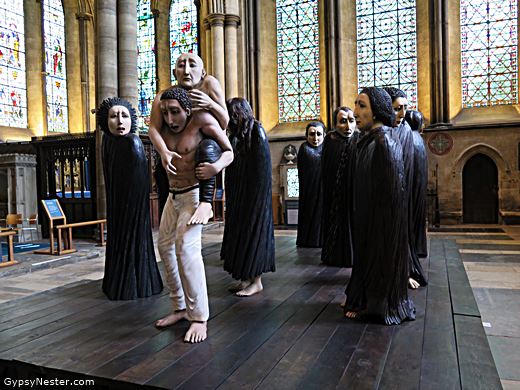 Created by Ana Maria Pacheco, each darkly engaging form is carved from a single lime tree, giving them a sturdy and solid presence that was mesmerizing for us. As a group they look haunted while striving to rescue a fellow wanderer.
Created by Ana Maria Pacheco, each darkly engaging form is carved from a single lime tree, giving them a sturdy and solid presence that was mesmerizing for us. As a group they look haunted while striving to rescue a fellow wanderer.

We circled the platform that they were standing on several times trying to take it all in. It is a powerful piece and we were extremely glad that we were lucky enough to see it before the showing ended in July of 2017.
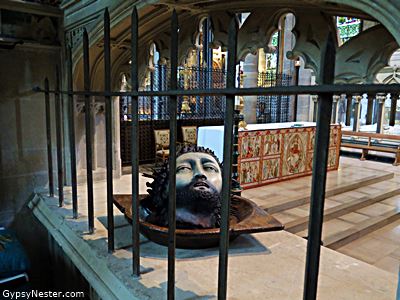 As we explored the rest of the church we noticed that several other works by Ms. Pacheco were also on display. The head of John the Baptist on a platter was by far the most jarring, with the realism being somewhat disturbing.
As we explored the rest of the church we noticed that several other works by Ms. Pacheco were also on display. The head of John the Baptist on a platter was by far the most jarring, with the realism being somewhat disturbing.
The cathedral also houses two incredible historic items. We encountered the first almost by accident since it is presented with very little fanfare. Perhaps less than it deserves as the world’s oldest working clock.
Dating back to 1386, it was originally located in a bell tower and has no face since the hours were rung out on the bells.
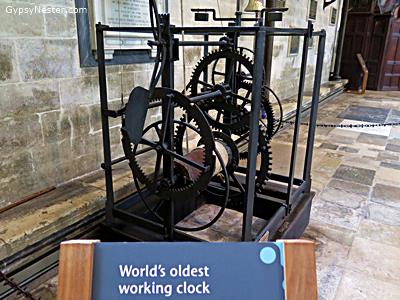
The tower was demolished in 1792 and the clock moved to another until 1884 when it was stored away. The ancient timepiece was rediscovered in 1929, then restored in 1956, and has taken a licking but keeps on ticking today.
The other, even more impressive historic artifact has a special room to house it just off of the main church. The former chapter house, or meeting room, now holds one of the last four remaining originals of the Magna Carta.
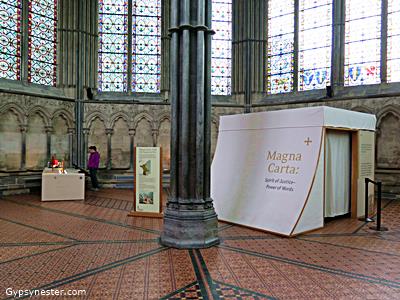
This is considered to be the best-preserved surviving hand written copy of the document that arguably set the standard for all civil liberties to come.
In 1215 the Magna Carta Libertatum, which is Latin for the Great Charter of the Liberties, laid out rules restricting monarchs from abusing their power and granting rights to subjects, including rules on taxation, freedom of the church, and trail by a jury of one’s peers.
The document is so fragile, and valuable, that it can only be seen inside a special protective tent and no photographs are allowed, but we promise, we actually did get to see it, even if we don’t have a selfie to prove it.
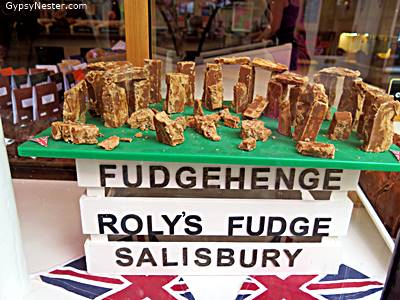 On our way out of town we happened to notice a display in a candy shop window that brought us full circle to the giant stone circle that had lured us here.
On our way out of town we happened to notice a display in a candy shop window that brought us full circle to the giant stone circle that had lured us here.
The confectioner had created a scale model of Stonehenge out of fudge and proudly presented Fudgehenge.
Now that we could take a picture of… and were glad we stayed awake to see!
David & Veronica, GypsyNester.com



What a nice corner of England … jet lag can be such a drag – good to see you didn’t let it keep you down!
We were so happy to discover Salisbury that it made us hardly notice the jet lag…. almost.
We love visiting the Salisbury Cathedral. One of the UK’s most iconic medieval buildings (houses the world’s oldest working mechanical clock and beautiful stained glass art) – it is a must-see.
We were certainly happy with our choice as a base camp to see Stonehenge. Wonderful town!